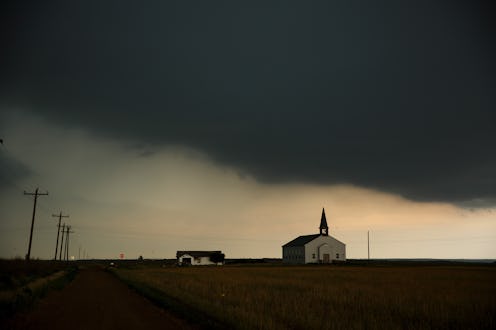News
Exactly What To Do During A Tornado
Tornados raged across the Midwest this week, providing a harsh reminder of the destructive power of Mother Nature. While tornadoes often seem to be more the stuff of fictional films and impossible plot points (Sharknado anybody?) they're far more serious than Dorothy in The Wizard of Oz makes them out to seem. Misunderstanding or underestimating them can be dangerous or even lethal.
According to LiveScience, 800 tornadoes are reported each year, resulting in 80 deaths and 1,500 injuries. But despite being a relatively common occurrences, tornadoes remain shrouded in mystery, with several misconceptions surrounding these powerful funnels. Here are some common myths about tornadoes, and what you should really be doing in the face of the twisters.
Myth: Opening the windows to equalize pressure in your house is the best defense against tornadoes
While tornadoes themselves are caused by the differences in pressure that result when cold air traps warm air beneath it, forcing the warm air to rotate, your house will not explode due to pressure differences inside and outside the house. In fact, taking the time to open all the windows in your house will waste precious time that should otherwise be used getting to safe shelter.
Moreover, opening windows could also increase the chances fast-moving debris entering your house and hitting someone. Homes are not destroyed by differences in air pressure, but rather by extreme wind speeds.
Truth: Extreme wind speeds, not differences in air pressure, cause tornado damage
The fastest winds ever recorded in a tornado hit speeds over 300 miles per hour. Even the "smallest" tornado has winds of at least 40 mph, and a "mid-sized" tornado has winds that travel around 160 mph. Tornadoes can also move at a speed of up to 70 mph, which means that you have essentially no chance of outrunning one, and should probably avoid trying to outdrive one as well.
Myth: The southwest corner is the safest place to hide from a tornado
For some time, people thought that because tornadoes generally come from the southwest, debris would naturally fall in the northeast corner of a building. However, this is untrue because tornadoes do not normally travel in a straight line or in any predictable pattern, which means that winds could blow in any direction. Furthermore, tornadoes themselves can hit a building from any direction, and as such, there is no one geographical location in your house that is safest.
Truth: The best thing to do is to find a windowless room on the lowest floor
This will be the best protection against flying debris and heavy winds. While hiding directly under a desk, bench, or a mattress can be helpful, you should avoid positioning yourself in an area that is beneath a heavy object on the above floor. This protects you from the possibility of having a large object like a piano or dining room table come crashing down on you.
Myth: Tornadoes cannot cross bodies of water
Don't think that making it to the other side of the river is a failsafe for protecting yourself against a tornado. Water has not been shown to have any sort of effect on the path of tornadoes, and several tornadoes have been noted to cross lakes and rivers before making landfall. In fact, the deadliest tornado in recorded history, the Tri-State tornado of 1925, crossed both the Mississippi and the Wabash Rivers.
Truth: Tornadoes that form over water are called waterspouts
While waterspouts generally dissipate before reaching land, they are just as dangerous over water, reaching wind speeds of between 80 and 100 mph. Researchers estimate that about 500 waterspouts form annually off the coast of Florida.
